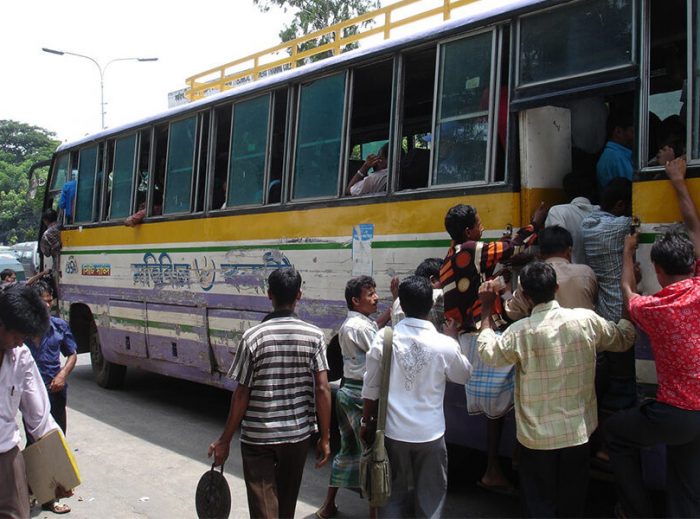New findings on the spillover effects of migration subsidies in Bangladesh

Migration and Informal Insurance
Every year, rural residents of Bangladesh face seasonal poverty and hunger during the agricultural lean season. Known as the Monga in Bengali, this period occurs between planting and harvesting when agricultural jobs are scarce; if residents don’t find a way to supplement their incomes, they can suffer from malnutrition and starvation. Two common coping strategies to address this uncertainty are informal insurance networks – lowering risk by sharing resources with community members – and temporary migration to urban areas for work.
In a recent paper, EGC affiliates Mushfiq Mobarak and Costas Meghir and Yale graduates Corina Mommaerts and Melanie Morten build on previous literature exploring the direct effects of migration subsidies by examining their broader interaction with community risk-sharing. Combining evidence with a novel theoretical model, the authors find that migration subsidies had a positive impact on both risk-sharing and welfare in Bangladesh, but stress that outcomes can vary dramatically depending on local context.
Migration subsidies in Bangladesh led to an increase in community risk-sharing, with the correlation between individual households’ income and their consumption decreasing by 40 percent.
Accounting for these community spillover effects more than tripled the estimated welfare gains for Bangladeshi communities that received the subsidies, from 3.4 to 12.9 percent.
Modeling the complex interaction between migration and risk-sharing predicts different impacts from alternative policy levers: permanent conditional subsidies worsen risk-sharing but improve welfare, while an unconditional cash transfer improves risk-sharing slightly but has a negligible impact on welfare
The results indicate that decision-makers need to think more deeply about local context and indirect effects on communities when designing social protection policy.
Direct extrapolation from experimental results to policy can be misleading.
According to the UN, nearly 3.8 billion people around the world live in rural areas. With agriculture as a primary source of income, rural residents bear the brunt of weather fluctuations, poor harvests, and changes in agricultural commodity prices. Between the planting and harvesting seasons, as demand for agricultural labor drops off, wages fall, job opportunities often decrease, and household consumption may decline, increasing the likelihood of malnutrition or famine.
“Formal financial instruments could help smooth out that income variability, but in many low-income countries that formal market isn't present,” explained coauthor Melanie Morten PhD ’13, now Assistant Professor of Economics at Stanford University. "As a result, there's a really rich set of informal institutions that people use to plug this gap.”

Agricultural work during the peak season in Rangpur District, northern Bangladesh. Photo by Vestal McIntyre.
Rural communities have two primary methods of coping with income uncertainty and smoothing consumption over the non-harvest season: community risk-sharing mechanisms (also known as informal insurance) and seasonal migration. The first works as networks of community members help their neighbors when in need. Whether unofficial cash loans, gifts, food, or services, these contributions help buffer against income shocks in rural areas lacking formal financial institutions for saving and borrowing.
What can history tell us about the migration crisis brought on by India’s Covid-19 lockdown?
Watch “Migration in crisis: Insights on Covid-19 from past pandemics” – part of Yale Development Dialogues webinar series.
“Within a village, you're sharing income and consumption,” said coauthor Corina Mommaerts, PhD ’16, now Assistant Professor of Economics at the University of Wisconsin-Madison. “You're helping each other out when times are tough, and there's not really a written contract. It's an implicit contract – but of course, there's only so far that implicit contracts can go.” That is, informal insurance is limited by how much extra resources community members have and are willing to share.
The second method, seasonal migration, creates an outside stream of income for households during the lean season as one or more members temporarily seek higher wages in urban job markets. Yet migration itself may be too risky or costly for rural households to undertake, since families must pass up a lower but more predictable income source in the village to take advantage of higher – but uncertain – city wages.
Interactions and Approach
The authors note that new migration opportunities and risk-sharing networks can jointly influence one another, meaning changes in a household’s ability to share risk can affect migration and vice versa. “If you can encourage lots of people to move, that may have an unintended consequence on the people who cannot leave or the people who don’t get that opportunity,” explained Mobarak, Professor of Economics and director of the Yale Research Initiative on Innovation and Scale (Y-RISE). “Once some people migrate, does that improve risk-sharing or does that worsen it? Does it make the other people better off or worse off? You could imagine it going in both directions.”
A key finding of the paper is that much depends on a community’s existing economic environment and the degree to which migration is considered risky. Migration can positively contribute to informal insurance networks by providing additional income for the community to share, but the option to earn supplemental city income could also undermine them by decreasing community members’ incentive to participate in risk-sharing. If migration is seen as a very risky activity, individuals may increase participation in risk-sharing to hedge against the chance of failure. If migration is seen as very safe, individuals deciding to migrate may not need to rely on local informal insurance and thus may participate less in risk-sharing.
When you are thinking about a policy and its effects, you cannot just focus on the people you are working with directly. You have to think seriously and carefully about the various markets where those beneficiaries may interact with others. You have to think both about the direct and indirect effects.
- Mushfiq Mobarak
In order to better understand the complex interactions between migration and informal insurance, the authors developed a theoretical model of risk-sharing accounting for migration decisions.
“There’s a tension in research between expansive models – which are often difficult to validate but allow us to think broadly – and experiments, which if conducted well can give you very solid answers to a relatively narrow question,” explained Meghir, the Douglas A Warner III Professor of Economics.
To bridge this gap, the authors combined the experiment’s data with their novel model of endogenous migration and endogenous risk-sharing. This hybrid method captures interactions between the two and reconciles the fact that migration subsidies can have varying effects on risk-sharing, depending on local context and policy design.
Parental engagement and skills development
Costas Meghir and fellow EGC affiliate Orazio Attanasio collaborated on research on how early-childhood programs build cognitive and socio-emotional skills among children in Colombia
Mobarak elaborated: “This approach – combining an experiment that gives you good, high quality, variational data with modeling – is the only way for us to provide a more comprehensive picture.”
How Migration Can Improve Risk-sharing and Increase Welfare
The initial study this paper builds upon used a randomized controlled trial to introduce a 600 taka (about $8.50) migration subsidy to very poor agrarian households conditional on a member temporarily migrating, with an additional 200 taka for checking in with the research team at the migration destination – in total, enough to cover a round trip bus fare and a few meals. The subsidy was found to both increase migration (22 percent) and consumption (30 percent) in the first year for those induced to migrate, and migration remained higher (11 percent) during the next lean season (a year after the one-time subsidy was removed). Notably, the benefits of providing subsidies for temporary migration extended to the entire community: both migrants and non-migrants saw the correlation between income and consumption decrease by 40 percent. In other words, each household’s consumption level was less dependent on individual income due to increased risk-sharing within the community.
This observed change in risk-sharing implies that looking only at the direct effects on subsidy recipients provides an incomplete understanding of the total welfare effects of migration subsidies. For example, the researchers found that households in treatment communities were more likely to report receiving help from their networks of friends and family and also expressed a higher “willingness to help” than communities that did not receive subsidies – suggesting that migration can increase participation in informal insurance networks more broadly.
Taking into account these improvements in risk-sharing, the authors estimate that migration subsidies led to welfare gains equivalent to a 12.9 percent increase in consumption the year they were introduced. Without improved risk-sharing, they estimate that the consumption-equivalent gain would have been only 3.4 percent. This means that improvements to informal insurance networks associated with migration led to a three-times larger welfare increase in communities that received the subsidies.
Implications of Alternative Policies
Having refined their model with experimental variation, the authors use it to conduct two alternative policy experiments. First, they consider a permanent migration subsidy. Their model suggests that a permanent subsidy would lead to a 2.9 percent reduction in risk-sharing and a 13.5 percent increase in welfare – or just 40 percent higher than the expected welfare without subsidies, compared to the three-fold gains noted above for the temporary subsidy. In other words, while permanent subsidies reduce the cost of migration, they can worsen community risk-sharing and decrease welfare in the long term through the loss of insurance from informal networks.

Migrant workers board the bus to the city. Photo courtesy Y-Rise.
“Whether it goes one way or the other really depends on the scope of the policy,” explained Meghir. “If your policy is to introduce people to migration by a one-off subsidy, insurance allows members of the community to take advantage of the opportunity while mitigating the risk associated with temporary migration. A long-term subsidy to migration can however undermine the implicit insurance by making it more tempting to go it alone and keep all the migration benefits for themselves. The implication is that the experimental results, which relate to a strictly one-off travel grant, can be very different from the implications of a policy introducing a permanent subsidy.”
Next, the authors consider a temporary unconditional cash transfer versus the temporary conditional migration subsidy. The model suggests that temporary unconditional cash transfers would not substantively impact migration and would only slightly improve risk-sharing. Such transfers also would have a negligible effect on welfare net of the subsidy itself. Such large differences in the results of the authors’ counterfactual policy experiments underscore the need for careful consideration when designing policy interventions.
Lessons for Policy Design
Whether in its analysis of risk-sharing networks or counterfactual policy considerations, this paper reveals the need for decision-makers to think more deeply about the positive and negative spillovers that their policy choices may have. While both the permanence and conditionality of subsidies can change their effects on direct beneficiaries, it’s important to recognize that policy interventions can also have ripple effects in broader communities. Policymakers must consider such spillovers in order to create more effective social protection programs.
“When you are thinking about a policy and its effects, you cannot just focus on the people you are working with directly,” explained Mobarak. “You have to think seriously and carefully about the various markets where those beneficiaries may interact with others. You have to think both about the direct and indirect effects.”
Research summary by Shawn Thacker.